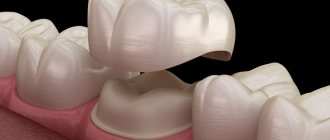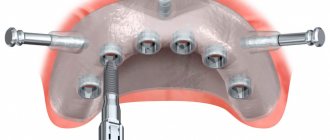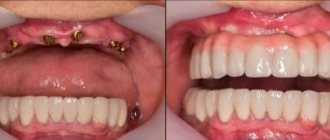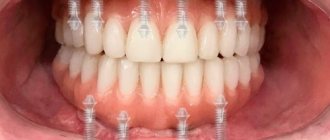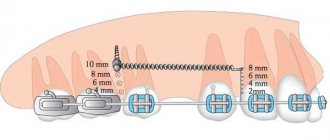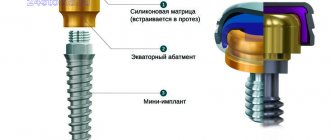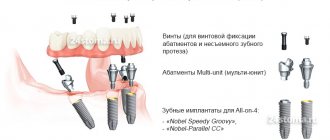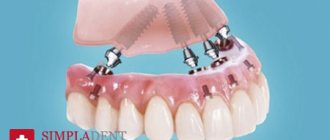The absence of even one tooth can cause both physical and psychological discomfort. That is why the simultaneous implantation procedure is very popular among patients. In a maximum of two visits, the patient solves his problem and gets a beautiful and healthy smile. As with any operation, dental implantation has its contraindications. Below we will look at all the features of the procedure and tell you for whom this method is suitable and who should resort to other procedures.
Single-stage implantation: what is it?
Instant prosthetics involves installing an implant immediately after removing a damaged tooth. This method is considered the most gentle and is recommended by doctors for those patients who do not have serious contraindications.
A thorough examination of the oral cavity should be done in advance, and if sanitation is indicated, the doctor will perform it before surgery.
The history of the express method of dental implantation
Back in the middle of the last century, Swedish professor Brenemark discovered the amazing property of titanium to organically fuse with bone tissue. This is how titanium implants appeared.
As a rule, implantation occurs in two stages: first, a titanium base of a new tooth is installed, which takes 4-6 months to grow into the bone tissue. And then a zirconium, composite or metal-ceramic prosthesis is attached.
During the period of ingrowth of the titanium implant, the hole remains empty or closed with a plastic insert. However, this type of implantation is not acceptable for all patients. This is how new, revolutionary protocols emerged that allow the installation of new teeth in one stage: All-on-4, All-on-6, basal implantation.
The main advantage of one-stage implantation is that after installing the titanium base, a temporary prosthesis is immediately placed on it, which is replaced with a permanent one after the implant has completely grown in.
This express method is often used for targeted restoration of damaged teeth in the smile area, because... In one visit, you can remove tooth fragments and immediately install a temporary crown.
Installing an implant immediately after tooth extraction - types of surgery
There are three main types of this procedure for restoring teeth immediately after their removal. The first is instant implantation, when after installing the implant, the gums in the place of the just extracted tooth are sutured, and further manipulations are performed only after complete healing. In the second case, during immediate implantation, in addition to the implant itself, the patient is also fitted with a gum former, which helps in the future to preserve the so-called “pink aesthetics”, that is, the natural and neat appearance of the soft tissue at the implantation site. Gum formers can be standard or custom-made; which one to choose depends on the situation.
The third type of one-stage jaw implantation is the installation of an implant in place of an extracted tooth with immediate loading of the latter with a temporary crown. After the implant has healed, this temporary crown is replaced with a permanent one. This subtype of instant implantation is by far the most effective from an aesthetic point of view, as it allows you to fully restore the pleasant appearance of your smile in one visit, so that the patient does not have to walk around with a “hole” in the dentition for the entire healing period. This type of express implantation is most in demand when restoring teeth in the smile zone, that is, in the anterior region.
Indications for implantation
All medical procedures are carried out solely according to indications. Experts recommend that patients resort to simultaneous implantation for the following problems:
- restoration of the front row of teeth;
- trauma with soft tissue damage;
- severe tooth deformation;
- tooth extraction due to gum disease;
- urgent tooth restoration.
List of mandatory requirements for the procedure
During the initial examination, the doctor will assess the condition of the oral cavity for the possibility of carrying out immediate implantation. The procedure is performed only if the following requirements are met:
- Suitable volume of bone tissue.
- There is no inflammation in the area of the tooth root;
- Bone tissue without atrophic changes;
- The area of the extracted tooth without obvious tissue deformations;
- The gums are in satisfactory condition;
- The interradicular septum must be preserved.
How long after tooth extraction is implantation possible?
Until relatively recently, it was considered extremely undesirable to carry out implantation immediately after a dental unit has been removed, due to high risks. However, modern dentistry uses advanced technologies, which allows implants to be placed immediately.
Thus, during one visit to the dentist, a tooth is removed and an implant is inserted. However, there are a fairly large number of restrictions. It is not possible to perform the operation immediately if:
- there is inflammation in the area where the tooth was removed;
- not enough bone tissue;
- There are dental diseases that require preliminary treatment.
The professionalism of the doctor is also of great importance. It is important that the removal is carried out as efficiently as possible. In addition, the requirements for the quality of implants are increasing significantly.
Benefits of dental implantation immediately after extraction
Despite existing restrictions and contraindications, the operation is in demand. This is due to the fact that immediate implant placement has a number of important advantages:
- In one operation, three interventions can be performed at once - tooth extraction, implantation and gum shaping. This saves time and also reduces patient costs;
- As a rule, there is no atrophy of bone tissue, and therefore no bone grafting is required. This simplifies the implantation process, reduces its duration and makes the operation more affordable financially;
- there is less risk of the implant being in the wrong position. If it is implanted into the socket of a newly removed dental unit, position correction is much easier to perform;
- the patient's psychological comfort increases. This is due to the fact that if the operation is performed in a short time, there is no risk of developing a “toothlessness complex”.
When should immediate implantation be performed?
Implantation is a surgical intervention, and therefore it requires indications. General indications are the following:
- there are no healthy teeth that can be used as support;
- complete edentia is observed;
- the patient does not want or cannot wear a removable denture;
- it is necessary to restore the front teeth and achieve maximum cosmetic effect.
Indications for implantation immediately after tooth extraction are as follows:
- there is an injured dental unit;
- there is a root fracture;
- The dental crown has collapsed.
How is immediate implantation performed?
Several methods of immediate implant installation are used in dental practice:
- insertion of a pin into the socket of a removed dental unit, suturing. After complete healing, prosthetics are performed;
- installation of a gum former, which provides an aesthetic effect. This is especially important if front teeth are being removed;
- implantation of an implant on which a temporary prosthesis is installed. This allows you to put a load on the structure. After engraftment, the temporary structure is replaced with a permanent one.
The operation is carried out in several stages:
- First, preparations are made for the intervention and suitable structures are selected;
- then the tooth is removed, after which an implant is implanted into the bone;
- then sutures are placed on the gum;
- If necessary, a gum former is also installed.
The main problem with delayed surgery is the risk of bone atrophy. That is why we can confidently say that immediate surgery is the most preferable. The specialists of the dental complex "PRESIDENT" have extensive experience in performing this task. Entrust your health to true professionals in their field - immediate implantation at PRESIDENT will allow you to solve your dental problem as quickly as possible!
Contraindications to one-stage dental surgery
Medical intervention should not be carried out if the patient has contraindications for this, which are divided into the following types:
- absolute (operation excluded);
- local (depending on the condition of the jaw);
- relative (the decision about the operation is made by the doctor).
The doctor eliminates all risks at the first examination and carefully examines the patient’s medical history. During the conversation, clarifying questions are asked to provide a complete picture of past and chronic diseases.
Let's consider absolute contraindications, in which simultaneous implantation is completely excluded:
- Allergy to the administration of anesthesia.
- Various blood diseases.
- All degrees of diabetes.
- Weak immunity.
- The bone tissue has undergone atrophic changes.
- Connective tissue does not recover quickly enough.
- Chewing muscles are in strong tone.
- Tuberculosis.
- The endocrine system has pathologies.
- Venereal diseases.
- Tumors of a malignant nature.
- Presence of mental illness.
- HIV infection.
Relative contraindications
These contraindications are only an obstacle to immediate implantation. The doctor decides how risky the procedure is.
- The gums are subject to inflammation.
- Some teeth require sanitation.
- The bite has pathological disorders.
- Presence of arthrosis changes.
- Tobacco use.
- Arthritis.
- Alcohol and drug addictions.
- Any trimester of pregnancy.
- The oral cavity is in unsatisfactory hygienic condition.
- Marginal periodontitis.
Local contraindications
- There is not enough bone tissue.
- The jaw arch is not dense enough and its structure is damaged.
- The short distance to the sinus makes the operation labor-intensive.
Temporary factors under which the procedure is possible
The doctor gives permission to perform the operation after the patient resolves the issue with the following factors:
- Chemotherapy.
- The period of rehabilitation after a somatic illness;
- Exacerbation of chronic and other diseases;
- Pregnancy.
After a course of chemotherapy, you should wait at least a year and only after this period can you have surgery. Let's not hide it - there is always a risk of implant rejection and the doctor will not give you a 100% guarantee, but the result is quite justified: the artificial tooth will look like a real one.
Despite the rather long list of contraindications, some of them can be corrected and treated. In addition, the procedure can also be performed by people of retirement age, which makes this procedure accessible and popular among patients of dental clinics around the world.
Risks of instant dental implantation
To be absolutely frank, we have to admit that with one-stage implantation, the percentage of implant rejection is slightly higher than with two-stage implantation, but this percentage still remains negligible (provided that all standards are met). Moreover, this risk is justified, especially in cases where a quick, highly aesthetic result is required. In general, the risk of implant rejection when installed using one-stage technology is associated with the following factors:
- severe gum injury after tooth extraction;
- accumulation of plaque around the hole not protected by the gum;
- not very strong implant fixation;
- immediate loading of the implant with a temporary crown.
Advantages of one-stage dental implantation
Here we will look at the benefits of the procedure and talk about why patients choose it and doctors recommend it:
- the procedure takes place in a short time - a maximum of two days;
- the health of neighboring teeth is preserved;
- less manipulation than with classical implantation;
- gum formation begins immediately after the installation of the abutment and crown;
- pronounced aesthetic effect - the artificial tooth looks like a natural one.
It is obvious that one-stage implantation is significantly superior to traditional (classical) implantation, because it is not only more affordable, but also less traumatic. You don’t have to go to the clinic for a long time, just 2 days and your smile will be beautiful and natural.
Fixation of a fixed prosthesis –
All-on-6 is an implantation protocol that involves immediate loading of a fixed denture. This means that already in the first 2-3 days after the operation, a completely non-removable denture will be fixed on your implants, with which you can immediately start chewing (though at first only soft food). However, the All-on-6 implantation protocol also implies that at first only a temporary fixed denture will be made for you - it is also called an adaptive one.
Temporary adaptive prosthesis on 6 implants –
The adaptation prosthesis is included in the price of All-on-6, which the clinic will quote you at the first stage. But the stage of permanent prosthetics is already paid additionally. The cost of All-on-6 will depend not only on the selected implant manufacturer, but also on the design of the temporary adaptive prosthesis, which can be made either with a metal frame or without a metal frame. In fact, this is a very important point that is worth paying attention to.
- Adaptive prosthesis without a metal frame - this version of the prosthesis will be fixed on implants within 2-3 hours after surgery.
This fixed prosthesis is quite simple to manufacture, but you can only use it for up to 5-6 months, after which it will need to be replaced - with a permanent fixed prosthesis. If you choose Nobel Biocare implants and an adaptive prosthesis without a metal frame, the price for All-on-6 will be about 400,000 rubles (turnkey). But this prosthetic option is not suitable if you have large jaws and well-defined masticatory muscles, if you have bruxism, and also if you plan to go on business trips or on vacation. The fact is that a prosthesis without a frame has a high risk of breaking, and if this happens in another city, and you cannot immediately contact an implantologist, this risks losing not only the prosthesis, but also all the implants.
- Adaptive prosthesis with a metal frame - this version of the prosthesis will be installed on implants only 2-3 days after the operation, which is due to the complexity and labor-intensive manufacturing.
The metal frame gives the prosthesis strength and reliability, and therefore it can be used for an average of 2 years, and a maximum of up to 3 years. If you choose exactly the same Nobel Biocare implants and taking into account the fact that the adaptive prosthesis will already have a metal frame, the price for All-on-6 will be about 530,000 rubles (turnkey). If the patient is a man, the prosthesis must definitely be chosen with a metal frame. Moreover, patients with bruxism are excellent at breaking even dentures with a frame, and they are additionally sent for botulinum toxin injections into the masticatory muscles (to relieve hypertonicity of the masticatory muscles). Abroad, for example, temporary dentures without a frame are not made at all; this is only Russian know-how, which allows reducing the cost of the service for the patient.
Important: thus, when choosing a prosthesis with or without a frame, the cost will differ by up to 130,000 rubles. Also, if you don’t like the option of temporary prosthetics at all, you can consider the possibility of carrying out the basal implantation technique, which also allows you to get a permanent prosthesis in 2-3 days after the operation if you are completely missing teeth. This technique (unlike All-on-4 and All-on-6) assumes the possibility of immediately producing a permanent fixed bridge prosthesis.
Preparation for implantation
Simultaneous dental implantation is a complex procedure that requires preliminary diagnosis of the condition of the oral cavity for dental caries and the presence of various inflammatory diseases. Implantation can be started only after complete treatment. To obtain reliable information about the height or level of the bone tissue into which the implant is planned to be implanted, it is necessary to take an X-ray of the teeth. If it turns out that there is not enough bone tissue to perform the operation, the doctor will first augment it.
Price for All-on-6 implantation in Moscow (turnkey)
We have already said above that All-on-6 implantation was developed (Switzerland), and, of course, it is best to use implant models specially created for this technique.
We are talking about such implants as “Nobel Speedy Groovy” and “Nobel Parallel CC”. Clinical studies show that when using these types of implants, 96% of patients with complete absence of teeth in the jaw did not have any problems with the implants or prosthesis even after 10 years. If we use 6 implants and a multi-unit ABA, then the turnkey price for All-on-6 implantation will be approximately 400,000 rubles (if you choose a temporary adaptive prosthesis without a metal frame). If the fixed prosthesis has a metal frame, then the price of All-on-6 immediately increases to approximately 520,000 rubles. By the way, if we use non-original components from other manufacturers, the cost will not be much lower.
- All-on-6 on Straumann implants (Switzerland) - the Straumann company is another very well-known manufacturer of dental implants.
Her implants are of very high quality, but they may not be suitable for the All-on-6 technique if the patient has too thin an alveolar ridge on the lower jaw. In this case, Nobel implants will be preferable. The cost of All-on-6 when using Strauman implants is no different from the cost when using Nobel components. Accordingly, with a fixed prosthesis without a metal frame and with a metal frame, the price will also be 400,000 or 520,000 rubles.
- All-on-6 on Osstem implants (Korea) - this company has good implants of the TS-3 CA series, which are quite suitable for All-on-6. Provided that 6 Osstem implants are used and a temporary adaptive prosthesis with a metal frame is selected, the price will be only 370,000 rubles.
You can find out more about the characteristics of implants from these manufacturers using the links below. In these reviews, we detail the pros and cons of each implantation system.
→ Nobel-Biocare (Switzerland) → Straumann (Switzerland) → Osstem (Korea)
“All-on-6” with delayed loading of the prosthesis –
In the price lists of some clinics, you may be offered “All-on-6” with delayed loading of a fixed prosthesis, i.e. when prosthetics are performed only after 4-6 months. But in fact this is misleading, because... The “All-on-6” technique involves only the immediate loading of implants with a fixed denture, and what these clinics offer is the usual two-stage method of dental implantation.
The latter assumes that after installing the implants, it will be necessary to use a conventional removable denture for 4-6 months, and only after the implants have taken root will a fixed bridge prosthesis be made for you. The cost of this technique is somewhat lower. For example, the installation of 6 Nobel Biocare implants plus a conventional complete removable denture made of acrylic plastic will cost about 330,000 rubles. The stage of permanent prosthetics is also paid additionally.
Important: At the end of this article there is an “online dental implant calculator” in which you can select the missing teeth, the implant company, and the type of fixed denture. When you click the “CALCULATE” button, you will instantly see the cost of the selected implantation option, and you will also be able to compare the cost of this technique with alternative implantation techniques, for example, with the All-on-4 technique, with conditionally removable dentures on implants, and the basal implantation technique.
Reviews from patients 1 year after All-on-6:
Stages of one-stage implantation
Fear of the dentist is a fairly common problem, despite the fact that modern methods and materials can significantly reduce pain during treatment. The worries will not be so strong if you initially know all the stages of the procedure and see that there is nothing to fear:
- Before the operation, a consultation is always carried out with a detailed diagnosis of the patient’s condition.
- A CT scan of the jaw is performed.
- A decision is made on the advisability of the operation.
- The doctor makes a 3D simulation of the operation.
- The patient is given local anesthesia.
- Complete removal of the deformed tooth is performed;
- Using a special drill, a hole is drilled in the bone tissue of the jaw.
- The hole is expanded to the optimal diameter with a special tool.
- The implant is implanted through the root socket: the element is screwed into the jaw.
- Next, the abutment is fixed to the implant.
- A temporary composite crown is installed.
A temporary crown should be worn until the implant is completely healed. On average no more than six months. Then a permanent crown is installed from durable, abrasion-resistant materials: metal ceramics or zirconium dioxide.
How is the All-on-6 surgical stage performed?
We have already said above that the surgical stage of All-on-6 implantation implies that the implants are installed in the teeth position 6-4-2|2-4-6. The installation of implants can be carried out using 2 different types of surgical techniques, which will greatly affect the duration and traumatic nature of the operation. We have the following 2 surgical techniques with which All-on-6 implantation can be performed...
- using a surgical template,
- classical technique (without using a template), which implies the need to make incisions in the gums and detach the mucoperiosteal flaps from the bone - followed by suturing at the end of the operation.
a) Implantation with an individual surgical template –
For the patient, this is the most non-traumatic and comfortable version of the operation, and in this case, for the installation of 6 implants, about 45 minutes will be enough for us. An individual surgical template is something like a transparent mouthguard, which at the beginning of the operation is fixed to the toothless jaw using pins. In such a template, special guides will be made for the pilot drill or cutters, with the help of which the implantologist will form a bed for each of the implants.
This template is individual for each patient, and the position of the guides for the pilot drill and cutters is calculated and modeled in a special program on the computer where your CT scan is loaded. Thus, taking into account the topography of the bone tissue in the image, we can model the ideal position of the implants in the jaw, and then the position of the guides in an individual surgical template (this can be a “Nobel Guide” or similar).
All this will allow us to install 6 dental implants in the ideal position - without making incisions and peeling mucoperiosteal flaps from the bone. We will install implants only by making small holes in the mucous membrane. But, if we didn’t have a template, then the implant surgeon would have to see the surface of the jaw bone tissue with his eyes to install implants, and for this he would need to peel off the flaps (gum) widely.
Operation progress (with Nobel Guide template) –
Advantages of surgery with the NobelGuide surgical template:
- The operation lasts only about 45 minutes,
- no need to peel off mucoperiosteal flaps - makes the operation not only quick, but also easily tolerated even in elderly patients, and in addition - in the postoperative period there will be no severe pain, hematomas, swelling of the soft tissues of the face,
- the risk of complications (injury to nerves, maxillary sinuses) is reduced due to the fact that the template allows you to bypass dangerous anatomical formations,
- very often, the presence of a template allows you to do without bone grafting (even in patients with severe bone volume deficiency) - due to super-precise positioning of implants in the jaw bone tissue,
- This implantation technique can be performed even in patients with osteoporosis and diabetes mellitus, and is also optimal for patients with a complicated medical history (for example, in the presence of cardiovascular and other diseases).
b) Classic All-on-6 technique with flap detachment –
If we do not make a custom surgical guide, then to install the implants we will need to see the surface of the bone, which means we will simply have to make incisions and widely peel the gum from the bone. Below we will show you the progress of the All-on-6 operation on the upper jaw, where at the time the operation began, the patient had 6 front teeth with a high degree of mobility in the jaw (these teeth were removed at the very beginning of the surgical operation).
Classic technique of All-on-6 implantation –
* Please note that in addition to removing mobile teeth, the surgeon made incisions along the alveolar ridge of the jaw, after which mucoperiosteal flaps were detached from the bone. After this, the patient had 6 Straumann BLT implants installed, and the gums were sutured. It is worth noting that in this patient the flaps were folded back quite sparingly, because The patient had no noticeable loss of bone volume. Usually the flaps are folded back much wider, and this is what causes quite severe pain, swelling and bruises after surgery.
In addition, the need for flap detachment also leads to a longer healing period. Stitches applied are usually removed on the 10th day. And at the very end of the operation, the implant surgeon will screw the so-called “Multi-unit” abutments into the implants, which are the gold standard for permanent prosthetics of toothless jaws. Immediately after fixing the multi-unit abutments, the patient is sent to an orthopedic dentist for the manufacture of a temporary fixed adaptive prosthesis.
Recovery postoperative period
After the operation, the recovery period begins, the person has solved his problem and now there is an implant instead of a damaged tooth. How to care for it and what should you be wary of on the doctor’s recommendation until the tooth finally begins to feel like your own?
For the first few days, the patient will experience slight swelling, which will cause discomfort. This is normal because surgery was performed. It is worth avoiding excessive chewing loads during this period and carefully monitoring oral hygiene using special antiseptics. During the first month, the discomfort goes away, and the patient forgets that he has an implant installed.
Review statistics among specialists and patients
The one-stage prosthetics method began to be used in Russia relatively recently, while in Europe such services have been provided for several years. Analyzing world statistics, you can see that this method has collected a large number of positive reviews and enjoys well-deserved trust among both doctors and patients. The problem of a missing tooth is solved in record time.
Single-stage implantation also perfectly solves the aesthetic component of the problem: there are patients who do not like the look of their own teeth. They delay visiting the dentist and go without a tooth for a long time, not deciding on implantation. In addition, many people think that implantation takes a long time and are unable to find a place for the procedure due to their busy work schedule. However, the procedure is performed quickly and the installed tooth will look aesthetically pleasing and natural. Negative reviews can only be found regarding dissatisfaction with the price: the procedure is not budget-friendly and not everyone can afford it.
Which implant is better to place? Let's compare Dentium, MIS and Nobel implants
The optimal solution for tooth loss is dental implantation. The cost of this procedure varies greatly, largely depending on the implant chosen. Artificial roots for future teeth can vary in cost several times.
Let's look at 3 common implantation systems from different price categories.
Implant | Dentium | M.I.S. | Nobel |
Line of implants | Dentium SuperLine | MIS M4, MIS Seven | Nobel Activ |
Manufacturer | Dentium Co, South Korea | Medical Implant System, Israel | Nobel Biocare, Switzerland |
Survival rateStarSmile rating data is provided. The survival rate of budget implants may be overestimated due to the fact that doctors prefer to place them only under good clinical conditions. And more technologically advanced and expensive systems are installed in patients with bone grafting, chronic diseases, etc. | 98% | 97% | 99,3% |
Survival rateData provided by CosmoStom | 98,1% | 98,3% | 99% |
Lifetime WarrantyGuarantee of free implant replacement in case of rejection. | + | + | + |
VersatilitySuitable for narrow interdental spaces, etc. | + | + | + |
Atraumatic apexAre there models with a flat top, which are installed when there is a high risk of injury to the mandibular nerve or maxillary sinus? | + | + | + |
CompoundThe connection to the hexagon-shaped abutment ensures high tightness. | + | + | + |
Reviews from independent expert organizationsResearch data from the independent non-profit international scientific organization POSEIDO (Switzerland, Geneva). In 2014, the organization examined 62 implant models. | “Dentium Superline (DentiumCo., Seoul, Korea) is a sandblasted/acid etched surface. Inorganic contamination of the surface with silicon was detected. The surface is moderately micro-rough, nano-smooth, homogeneous throughout the entire body of the implant.” | “Implant surface sandblasted and acid-etched with ultra-pure 23 titanium alloy with extra low impurities. There were no signs of contamination or chemical modification of the surface." | “TiUnite (Nobel Biocare, Gothenburg, Sweden) is an anodized surface with a thick layer of titanium dioxide TiO2 (>100 nm). The surface is chemically altered by integrating large amounts of phosphorus during anodization. Inorganic surface contamination with fluorides and sulfates was also detected. The surface is microporous (pores are formed during anodization), smooth at the nanolevel with extended cracks that appear during the anodization process.” |
Other research and awards | No data | In 2015 - the best results according to the criteria for processing and cleaning the surface of implants in a medical study. University of Cologne (Germany). In 2022, the Congress of the Academy of Osseointegration (Los Angeles, USA) awarded MIS with the “CLEAN IMPLANT FOUNDATION” award - as a system with a perfectly clean implant surface | “The rough surface of TiUnite implants has been described in more than 275 publications based on the results of clinical studies involving more than 13,000 patients, using 42,000 implants and a follow-up period of up to 12 years,” the Nobel website reports and provides links to study data. |
Patient information supportAvailability of an official Russian-language website with useful information that can be understood without medical education. For patients, this is an opportunity to receive a qualified, reliable answer to their questions without repeated visits to the doctor. | — | + | + |
In the worldData on the prevalence of the implant in different countries of the world are indicated for 2022. Information taken from the official websites of manufacturers. Widespreadness indicates the recognition of the brand by doctors around the world. This factor is also important for those patients who are planning to move to another country. | Russia, China, Canada, Australia, etc. 10 countries + European Union. | 72 countries of the world | The most common brand of implants in the world. |
Own developmentsThe company develops innovative technologies in the field of implantology, and not only uses existing ones. | No data | + | + |
Surface | Rough SLA surface – sandblasting using coarse abrasive + acid etching. Proven and most widely used technology. | Rough SLA surface – sandblasting using coarse abrasive + acid etching. Proven and most widely used technology. MIS use well-known technology, but have brought its result to an ideally pure level. | Unique patented oxidized TiUnite surface |
All-on-4Prosthetics on 4 implants with complete absence of teeth | + | + | All-on-4 technology was developed by Nobel Biocare. Nobel implants are ideal for this type of treatment. |
Start of data collectionShows how long the company conducts research and observes the behavior of its implants after installation, long-term consequences and service life. | 2000 | 1995 | 1962 |
Summary | Dentium are inexpensive implants for most clinical cases. | MIS are universal implants with the cleanest surface, used when there is a risk of rejection. | Nobel - high-tech premium implants for complex clinical situations. |
Price
The technique of one-stage implantation requires the use of high-quality materials and modern equipment. In addition, the highly qualified implantologist is very important. The total cost of the procedure consists of consumables, the level of the doctor and the clinic. If the clinic has its own dental laboratory, the cost of the implant will be significantly lower. The average price for a turnkey installation is 45 thousand rubles. The service life of implants reaches 25 years, provided that high-quality materials are selected and the procedure protocol is strictly followed. The best implants are those made in Sweden, Israel and the USA.
Fixation of Multi-unit abutments –
We will only briefly touch on this stage, and you must remember only one thing - the abutments should only be “Multi-unit” (multi-unit). We say this because to save a little money you may be offered to use traditional types of abutments, but you absolutely cannot agree to this. Abutments are a kind of adapters between implants and a fixed prosthesis, and the service life of the implants and prosthesis also depends on their type.
We have already said above that the All-on-4/All-on-6 implantation concepts were developed by Nobel Biocare (Switzerland). To implement these concepts, Nobel Biocare has developed not only special types of implants, but also aba, which, at the very least, have already been copied by other implant manufacturers. Multi-unit abutments are fixed to the implants using screws, and in the future it is to these abutments that both temporary and permanent fixed bridge prosthesis will be fixed.
Fixation of multi-unit abutments:
Why are Multi-unit abutments so important?
The fact is that in the future we will have to remove the bridge from the implants many times and also fix it in place. This will be required, for example, when replacing a temporary adaptive prosthesis with a permanent bridge, as well as when carrying out regular professional cleaning of the prosthesis (carried out in the clinic once every 3-6 months). And the difference between traditional and multi-unit abutments will be as follows...
Multi-unit abutments are screwed to the implants using screws, and a fixed prosthesis is also screwed to the multi-unit abutments, but with different screws. And this allows us, when removing the prosthesis, not to remove the abutments from the implants (24stoma.ru). If traditional abutments are used, they are removed along with the prosthesis, because they do not have their own screw fixation system for implants. And this is very important, because... Every removal of traditional abutments leads to injury to the so-called “biological width”.
Roughly speaking, every time we remove a traditional abutment, we will receive an injury to the gingival cuff around the abutment, and this is very, very bad, because directly affects the risk of inflammation around implants and bone resorption around them. When we use multi-unit abutments, when removing the prosthesis they remain in the implants, and thus their use allows us to carry out all further manipulations at the stages of prosthetics - above the gum level.
